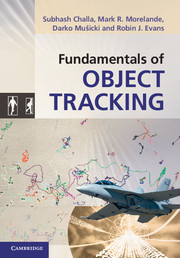Book contents
- Frontmatter
- Contents
- Preface
- 1 Introduction to object tracking
- 2 Filtering theory and non-maneuvering object tracking
- 3 Maneuvering object tracking
- 4 Single-object tracking in clutter
- 5 Single- and multiple-object tracking in clutter: object-existence-based approach
- 6 Multiple-object tracking in clutter: random-set-based approach
- 7 Bayesian smoothing algorithms for object tracking
- 8 Object tracking with time-delayed, out-of-sequence measurements
- 9 Practical object tracking
- Appendix A Mathematical and statistical preliminaries
- Appendix B Finite set statistics (FISST)
- Appendix C Pseudo-functions in object tracking
- References
- Index
1 - Introduction to object tracking
Published online by Cambridge University Press: 07 September 2011
- Frontmatter
- Contents
- Preface
- 1 Introduction to object tracking
- 2 Filtering theory and non-maneuvering object tracking
- 3 Maneuvering object tracking
- 4 Single-object tracking in clutter
- 5 Single- and multiple-object tracking in clutter: object-existence-based approach
- 6 Multiple-object tracking in clutter: random-set-based approach
- 7 Bayesian smoothing algorithms for object tracking
- 8 Object tracking with time-delayed, out-of-sequence measurements
- 9 Practical object tracking
- Appendix A Mathematical and statistical preliminaries
- Appendix B Finite set statistics (FISST)
- Appendix C Pseudo-functions in object tracking
- References
- Index
Summary
Object/target tracking refers to the problem of using sensor measurements to determine the location, path and characteristics of objects of interest. A sensor can be any measuring device, such as radar, sonar, ladar, camera, infrared sensor, microphone, ultrasound or any other sensor that can be used to collect information about objects in the environment. The typical objectives of object tracking are the determination of the number of objects, their identities and their states, such as positions, velocities and in some cases their features. A typical example of object/target tracking is the radar tracking of aircraft. The object tracking problem in this context attempts to determine the number of aircraft in a region under surveillance, their types, such as military, commercial or recreational, their identities, and their speeds and positions, all based on measurements obtained from a radar.
There are a number of sources of uncertainty in the object tracking problem that render it a highly non-trivial task. For example, object motion is often subject to random disturbances, objects can go undetected by sensors and the number of objects in the field of view of a sensor can change randomly. The sensor measurements are subject to random noises and the number of measurements received by a sensor from one look to the next can vary and be unpredictable. Objects may be close to each other and the measurements received might not distinguish between these objects.
- Type
- Chapter
- Information
- Fundamentals of Object Tracking , pp. 1 - 21Publisher: Cambridge University PressPrint publication year: 2011

